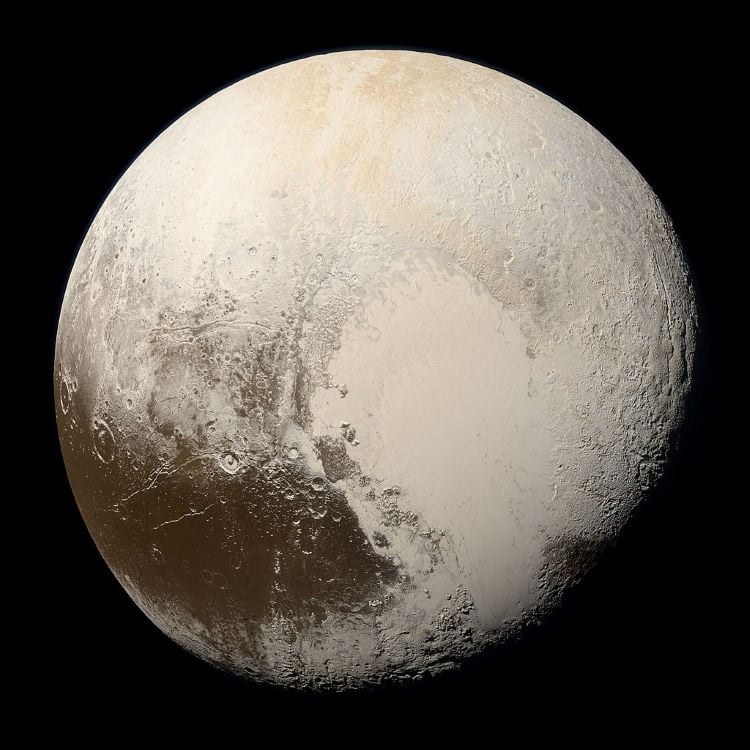Science
Researchers Uncover Evidence of Cryovolcanism on Pluto

A recent study published in *The Planetary Science Journal* has shed light on potential cryovolcanic activity in the Hayabusa Terra region of Pluto. Researchers focused on the Kildaze caldera, investigating its geological features to understand more about the dwarf planet’s current activity, especially given its distance from the Sun.
The team utilized images captured by NASA’s New Horizons spacecraft, which conducted a historic flyby of Pluto in July 2015. These images were compared with other known cryovolcanic sites on Pluto, such as Virgil Fossae and Viking Terra, and analog sites on Earth and Mars. Earthly counterparts included the Yellowstone caldera and Valles Caldera, while Martian sites featured collapsed pit craters in the Noctis Labyrinthus region.
Through rigorous analysis of the data, including digital elevation models and 3D visualizations, the researchers determined that the water ice within Kildaze is approximately a few million years old, a youthful age compared to the planet itself. They concluded that Kildaze is likely a cryovolcano with a caldera structure, which has experienced one or more eruptions, ejecting around 103 km³ of cryolava.
Cryovolcanism differs from traditional volcanism, as it involves the eruption of icy materials instead of molten rock. First identified in 1987, cryovolcanism has been observed across various celestial bodies, including Ceres, Europa, and Enceladus. Factors contributing to this phenomenon can include external impacts, tidal heating from gravitational interactions, or internal heat from radioactive decay.
What makes Pluto’s cryovolcanic activity particularly intriguing is its remote location in the solar system, where solar influence is minimal. This raises questions about the source of Pluto’s internal heat. Scientists are divided on whether this heat results from tidal interactions with its largest moon, Charon, or from radiogenic heating due to the decay of isotopes within Pluto’s core. A 2022 study published in *Icarus* posited that interactions with Charon might have allowed internal heat to be retained long after Charon itself cooled.
Since the New Horizons mission, no spacecraft has revisited Pluto, although several proposals for future missions have emerged, including an orbiter-lander combination powered by a fusion reactor that could reach the dwarf planet within four years. For perspective, it took the New Horizons mission nearly nine years to arrive.
As scientists continue to analyze the data collected during the New Horizons flyby, they remain hopeful that further research will reveal more insights into Pluto’s cryovolcanic history and current geological activity. The ongoing study of such phenomena not only enriches our understanding of Pluto but also contributes to the broader knowledge of cryovolcanism across the solar system.
-

 Science4 weeks ago
Science4 weeks agoALMA Discovers Companion Orbiting Giant Red Star π 1 Gruis
-

 Top Stories2 months ago
Top Stories2 months agoNew ‘Star Trek: Voyager’ Game Demo Released, Players Test Limits
-

 Politics2 months ago
Politics2 months agoSEVENTEEN’s Mingyu Faces Backlash Over Alcohol Incident at Concert
-

 World2 months ago
World2 months agoGlobal Air Forces Ranked by Annual Defense Budgets in 2025
-

 World2 months ago
World2 months agoMass Production of F-35 Fighter Jet Drives Down Costs
-

 World2 months ago
World2 months agoElectrification Challenges Demand Advanced Multiphysics Modeling
-

 Business2 months ago
Business2 months agoGold Investment Surge: Top Mutual Funds and ETF Alternatives
-

 Science2 months ago
Science2 months agoTime Crystals Revolutionize Quantum Computing Potential
-

 Top Stories2 months ago
Top Stories2 months agoDirecTV to Launch AI-Driven Ads with User Likenesses in 2026
-

 Entertainment2 months ago
Entertainment2 months agoFreeport Art Gallery Transforms Waste into Creative Masterpieces
-

 Business2 months ago
Business2 months agoUS Government Denies Coal Lease Bid, Impacting Industry Revival Efforts
-

 Health2 months ago
Health2 months agoGavin Newsom Critiques Trump’s Health and National Guard Plans









